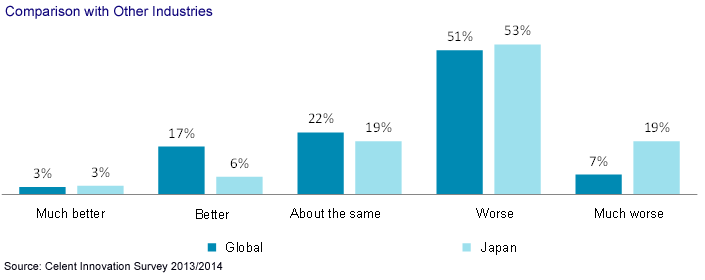Following on the heels of its global innovation survey last year, Celent conducted a survey on innovation in Japan’s financial industry. The survey targeted professionals at 110 of the leading financial industry firms, including solution vendors and the financial institutions they service such as banks, insurers, securities firms, and asset management firms.
Analysis of these results thrust into relief two gaps. The first is a management gap. The Japan survey results show that, in line with the rest of the world, innovation at financial institutions is highly dependent on the existing management structure — and that this tendency is pronounced in Japan.
The second is an initiative gap. A clear gap is evident in the thinking of financial institutions, which require technology-based solutions, and solution vendors to provide them.
The survey indicates a disconnect in the solutions that vendors offer and the solutions that financial institutions desire. Moreover, Celent sees significant scope for advancements in innovation initiatives on both sides.
The survey was designed to shed light on and gauge the level of innovation implementation at financial institutions. The survey included questions from Celent’s global innovation survey about the perceived importance of innovation, corporate initiatives, and barriers to innovation. In addition, it also asked financial institution professionals to assess innovation at their companies to compare the situations in Japan and elsewhere globally.
The Japan survey posed nearly the same questions to vendors. Celent compares the self-assessments of financial institutions with the responses of technology vendors to yield an analysis of the latest in innovation trends
The survey asked respondents an array of questions on innovation, including the perceived importance of innovation, anticipated benefits, barriers, innovation experience, organizational structures, departments that lead innovation, Net Promoter Scores (NPS), effectiveness of innovation tools, and digital financial services initiatives. In addition, the report includes some invaluable opinions Celent received via Twitter.

“In the increasingly diverse and complex worlds of Japanese financial institutions, leaving innovation to its own devices risks not only cannibalization of a company’s core business areas but of new businesses as well. To keep innovators from being ostracized as black sheep, it is important to clearly distinguish between the accumulation of kaizen (improvement) on a daily basis in core operations and disruptive innovation. In particular, it is important to direct management and initiative toward the latter,” says Eiichiro Yanagawa, a senior analyst with Celent’s Asian Financial Services practice and author of the report.
This report also offers innovation models to help companies intentionally induce innovation and to do so in an ongoing manner.
This is the first of a two-report series on innovation in Japan’s financial service sector. The report contains 24 figures.





